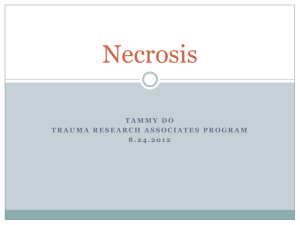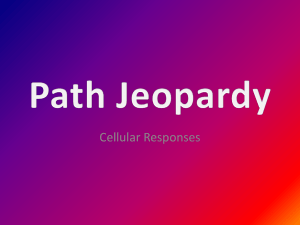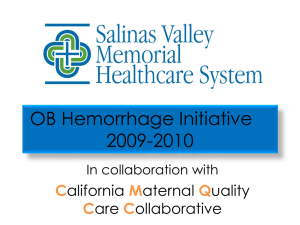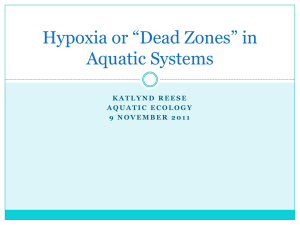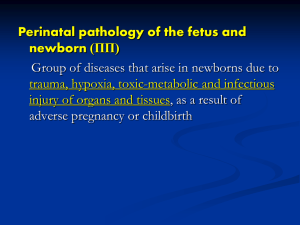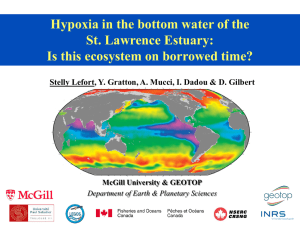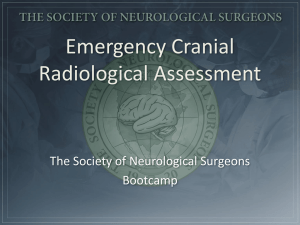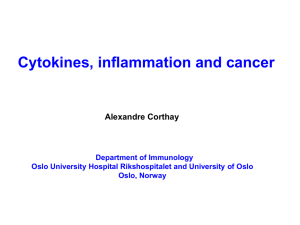HypoxiaIschemia - Division of Neuropathology
advertisement
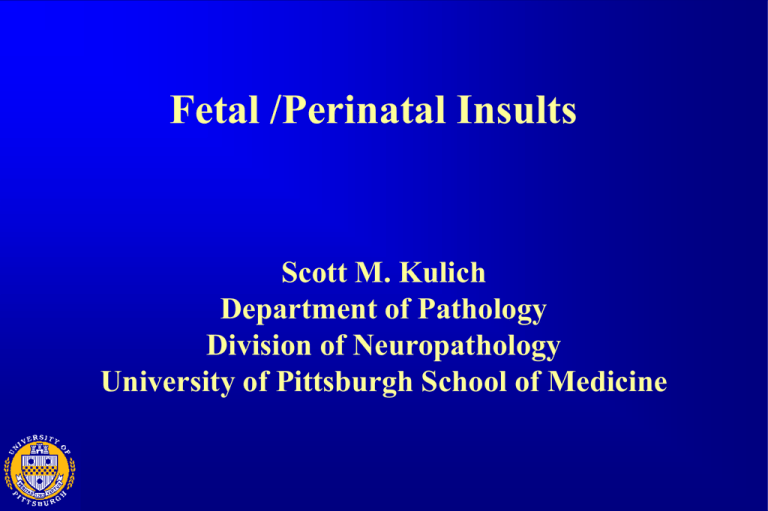
Fetal /Perinatal Insults Scott M. Kulich Department of Pathology Division of Neuropathology University of Pittsburgh School of Medicine Fetal /Perinatal Insults: Overview • Hypoxia\ Ischemia injuries •Early gestational (porencephaly, hydranencephaly) •Late gestational •White matter (Periventricular leukomalacia, multicystic encephalomalacia) • Gray matter (Cerebral necrosis, pontosubicular necrosis, thalamic and basal ganglia lesions) •Hemorrhage •Germinal matrix hemorrhage •Kernicterus Fetal /Perinatal Insults • Hypoxia\ Ischemia injuries •Early gestational (porencephaly, hydranencephaly) •Late gestational •White matter (Periventricular leukomalacia, multicystic encephalomalacia) • Gray matter (Cerebral necrosis, pontosubicular necrosis, thalamic and basal ganglia lesions) •Hemorrhage •Germinal matrix hemorrhage •Kernicterus Hypoxia\Ischemia: Overview •Very common injury •1.8-47 per 1000 live births •Sequela variable but include •Cerebral palsy •Mental retardation •Seizures Hypoxia\Ischemia: General concepts •Hypoxia –Can occur in a variety of clinical settings —Hypoxemic (low O2 content in blood e.g. CO) —Histotoxic: Cyanide poisioning —Anoxic: Drowning —Stagnant: Inadequate blood supply (ISCHEMIA) •Most common form of CNS hypoxia Hypoxia\Ischemia: General concepts •Selective vulnerability to hypoxia –Certain cell types are more vulnerable —Neurons more vulnerable than glia –Certain neurons more vulnerable to hypoxia –Adults: CA1 region of hippocampus, Purkinje cells of cerebellum, laminae 3 and 5 of cortex –Infants: Pons, subiculum, thalamus\basal ganglia Hypoxia\Ischemia: General concepts •Timing of lesion during development critical to determining type of lesion produced (Hydr = hydranencephaly, BB=basket brain, Por=porencephaly, MCE=multicystic encephalopathy SHE=germinal matrix hemorrhage, CPH=choroid plexus hemorrhage, WMN=white matter necrosis PSN=pontosubicular necrosis, C/Ul=cortical necrosis/ulegyria, Th/BG=thalamic/basal ganglia lesions) Modified from Neuropathology, Ellison and Love, 1998 Hypoxia\Ischemia: General concepts •Timing of lesion during development critical to determining type of lesion produced •Lack of astrocytes during early development •Smooth-walled cystic lesions of hydran\porencephaly •Metabolic demands of different regions of the brain differ at various points of development •White matter necrosis in 3rd trimester injuries •Hypoxic change in neurons differ depending upon time of injury •Karyorrhexis versus eosinophilia Hypoxia\Ischemia: Early developmental lesions •Hydranencephaly •Porencephaly (Basket brain, Schizencephaly) Hydranencephaly Due to hypoxic-ischemic injury during second trimester Usually affects the territories of middle and anterior cerebral arteries – Sparing of posterior fossa May live up to several years depending upon extent of central gray matter involvement Hydranencephaly: Gross Cystic hemispheres replaced by thin translucent membrane Sparing of inferior portions of frontal, temporal, and occipital lobes Posterior fossa structures also spared Hydranencephaly: Gross Hydranencephaly: Micro Cyst wall composed of outer connective tissue and inner layer with admixed neurons, glia, and macrophages Adjacent cortex usually with polymicrogyria Porencephaly Circumscribed hemispheric defect Also due to hypoxic-ischemic injury during second trimester Usually bilateral, symmetrical, and involves the Sylvian fissure or central sulcus Severe bilateral cases may also be called by other terms (schizencephaly, basket brain) Variable clinical manifestations – Severe cases: MR, epilepsy, blindness, tetrapelegia – Mild cases may survive into adulthood Porencephaly: Gross Smooth-walled defect Modified from Slide Atlas of Neuropathology, Okazaki and Scheithauer, 1988 Porencephaly: Gross Abnormal gyration pattern in surrounding tissue Irregularly thickened disorganized cortical ribbon leading into smooth-walled defect Modified from Neuropathology, Ellison and Love, 1998 Hypoxia\Ischemia: Late developmental lesions •White matter lesions •Periventricular leukomalacia •Multicystic encephalomalacia •Gray matter lesions •Cerebral necrosis •Pontosubicular necrosis •Status marmoratus •Ulegyria Periventricular Leukomalacia • AKA: PVL, white matter necrosis, white matter ischemia, and periventricular leukoencephalopathy • 5 % of all hospital births and up to 35 % of low birth weight newborns • Pathogenesis: Late 3rd trimester (28-32 weeks gestational age) hypoxic/ischemic damage •Watershed area •Area of high metabolic demand • Cystic lesions after resolution • Most infants develop spastic motor dysfunction (cerebral palsy) PVL: Gross Sharply circumscribed periventricular foci Common locations – Anterior to frontal horns – Angles of lateral ventricles – Lateral trigone Zone of Pallor PVL: Acute micro Coagulative necrosis – Nuclear pyknosis – Vacuolization – axonal spheroids Modified from Neuropathology, Ellison and Love, 1998 PVL: Micro PVL: Micro Subacute – Capillary hyperplasia – Foam cells Chronic – Gliosis Multicystic Encephalomalacia • Believed to result from hypoxic\ischemic insults near term or in the early post-natal period •Can be seen with other conditions (e.g. Herpes) •Usually results in death within weeks to months after insult. Multicystic Encephalomalacia Hypoxia\Ischemia: Late developmental lesions •White matter lesions •Periventricular leukomalacia •Multicystic encephalomalacia •Gray matter lesions •Cerebral necrosis •Pontosubicular necrosis •Basal ganglia/thalamic lesions •Ulegyria Cerebral Necrosis • Observed in term infants associated with •Intrapartum vascular complication (e.g. placental abruption) • Perinatal vascular problems • Congenital heart defects, hypotension • Lesion common between anterior and middle cerebral artery distributions • Neurological consequences • Hypotonia,abnormal eye movement, seizures, coma Cerebral Necrosis: Gross Diffuse cerebral edema Ribbon effect – Dusky white matter with cortical pallor Modified from Neuropathology, Ellison and Love, 1998 Cerebral Necrosis: Gross Cerebral Necrosis: Micro Pseudolaminr pattern Astrocytic hyperplasia Preferential Necrosis at depth of gyri Lipid laden Macrophages And capillary proliferation Modified from Neuropathology, Ellison and Love, 1998 Pontosubicular Necrosis -Hypoxic/ischemic insult to brain results in neuronal nuclear karyorrhexis -Seen in subiculum of hippocampal formation and scattered brain stem nuclei (other areas will exhibit more “mature” type of neuronal death) Ulegyria • “Scarred gyrus” •Chronic healed hypoxic ischemic insult to the cortex • Preferential involvement of •Depths of sulci (mushroom morphology) •Anterior-middle cerebral artery territories Ulegyria: Gross Mushroomshaped lesion Border of anterior and posterior cerebral artery distribution Ulegyria: Micro Thalamic and Basal Ganglia Lesions • Microinfarcts of thalamus and basal ganglia • Abnormal myelination (Status Marmoratus) • Clinical manifestations • choreoathetosis • mental retardation • spastic paraplegia • epilepsy • hyperkinetic if caudate is involved • Average age of death 12 years old Thalamic and basal ganglia lesions:Pathogenesis • Complicated parturition in 70 % of cases • cyanosis • resuscitation • convulsions • neurological signs • 1/3 have umbilical cord complications • Male predilection 2:1 Atrophy and discoloration of thalamus and basal ganglia Modified from Neuropathology, Ellison and Love, 1998 Gross Gross: Status marmoratus Mottled basal ganglia Modified from Neuropathology, Ellison and Love, 1998 Gross: Status marmoratus Fetal /Perinatal Insults • Hypoxia\ Ischemia injuries •Early gestational (porencephaly, hydranencephaly) •Late gestational •White matter (Periventricular leukomalacia, multicystic encephalomalacia) • Gray matter (Cerebral necrosis, pontosubicular necrosis, thalamic and basal ganglia lesions) •Hemorrhage •Germinal matrix hemorrhage •Kernicterus Neonatal Hemorrhages 1. Subdural hemorrhage 2. Subarachnoid hemorrhage 3. Subpial hemorrhage 4. Intracerebral hemorrhage of Hemorrhagic Infarction 5. White matter hemorrhage or hemorrhagic infarction 6. Germinal matrix hemorrhage 7. Choroid plexus hemorrhage Modified from Neuropathology, Ellison and Love, 1998 Germinal Matrix Hemorrhage (GMH) • AKA: Subependymal hemorrhage, intraventricular hemorrhage • Primarily occurs in low birth weight, premature babies under 34 weeks of age • Common associations include: • Respiratory distress syndrome, congenital heart disease, hypernatremia, coagulopathy • Occurs cases before 48 hours postpartum in 60 % of Pathogenesis of GMH • Fragile microcirculation at germinal matrix lacking support • Hypoxia -> Autoregulation failure -> Overperfusion • Focal endothelial cell necrosis • High levels of tissue plasminogen activator Normal Germinal Matrix 1. Large number of small dark blue cells in subependymal region 2. Most prominent: 22 to 30 weeks gestation. Grades of GMH Modified from Neuropathology, Ellison and Love, 1998 Grade 1 GMH Grade 1 GMH Grade 2 GMH Grade 2 GMH Grade 3 GMH Grade 3 GMH Grade 4 GMH Extension into parenchyma Modified from Neuropathology, Ellison and Love, 1998 Fetal /Perinatal Insults • Hypoxia\ Ischemia injuries •Early gestational (porencephaly, hydranencephaly) •Late gestational •White matter (Periventricular leukomalacia, multicystic encephalomalacia) • Gray matter (Cerebral necrosis, pontosubicular necrosis, thalamic and basal ganglia lesions) •Hemorrhage •Germinal matrix hemorrhage •Kernicterus Fetal /Perinatal Insults • Hypoxia\ Ischemia injuries •White matter •Periventricular leukomalacia • Gray Matter Ischemia • Cerebral Necrosis • Pontosubicular Necrosis • Thalamic and Basal Ganglia Lesions •Hemorrhage •Germinal matrix hemorrhage •Kernicterus Kernicterus “Jaundiced Nuclei” Selective yellow staining of the deep gray matter and brain stem due to deposition of unconjugated bilirubin Associated with neuronal necrosis and resulting neurologic sequelae Poor prognosis but condition is now rare in areas where hyperbilirubinemia can be predicted, monitored, and treated appropriately Pathogenesis of Kernicterus • Excessive production of unconjugated bilirubin (80 % from RBC’s) or insufficient conjugation/excretion by the liver • Unconjugated circulating form is neurotoxic • May occur in small or preterm infants at 10 mg/ml • Contributing factors • Blood-brain barrier damage • Reduced albumin or albumin binding •Dose dependence • 6-7 % of newborns > 12.9 mg/dl • 3 % of newborns > 15 mg/dl • Hyperbilirubinemia cause suggested by age of onset •< 1 day: Hemolysis\hematoma, infection •2-3 days: Infection, Criglar-Najjar, physiologic jaundice •1 week: Breast milk jaundice (pregnane-3beta, 20alpha-diol), congenital or drug-induced hemolytic anemias, hypothyroidism, biliary atresia, infections Pathogenesis of Kernicterus • Deposition of unconjugated bilirubin leads to necrosis of neurons in selected regions of the CNS •Mechanisms of anatomic specificity and molecular events leading to neuronal death are unclear •Neurologic sequelae vary •Acute: Lethargy, rigidity, hypotonia, opisthotonus •Chronic: Choreoathetoid movements, spasticity, ataxia, mental retardation Kernicterus: Gross pathology Key Red: Most vulnerable Brown: Least vulnerable Pink: Intermediate Modified from Neuropathology, Ellison and Love, 1998 Kernicterus: Gross pathology Kernicterus: Gross pathology Thalamus Hippocampus Modified from Neuropathology, Ellison and Love, 1998 Kernicterus: Gross pathology Dentate Nucleus Modified from Neuropathology, Ellison and Love, 1998 Kernicterus: Gross pathology Inferior olive Modified from Neuropathology, Ellison and Love, 1998 Kernicterus: Microscopic pathology • Changes do not necessarily correspond to intensity of staining •Acute •Cytoplasmic vacuolization, eosinophilia, chromatolysis, and spongy neuropil •Subacute •Astrogliosis and neuronal drop-out Acknowledgments and references Drs. Julio Martinez, Gutti Rao, and David Van Sickle Neuropathology, Ellison and Love, 1998 Greenfield’s Neuropathology, Graham and Lantos, 1997 Slide Atlas of Neuropathology, Okazaki and Scheithauer, 1988
